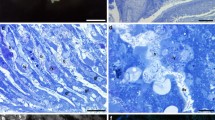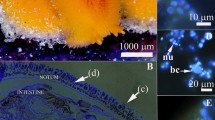Abstract
The marine bivalve Lucinoma aequizonata (Lucinidae) maintains a population of sulfide-oxidizing chemoautotrophic bacteria in its gill tissue. These are housed in large numbers intracellularly in specialized host cells, termed bacteriocytes. In a natural population of L. aequizonata, striking variations of the gill colors occur, ranging from yellow to grey, brown and black. The aim of the present study was to investigate how this phenomenon relates to the physiology and numbers of the symbiont population. Our results show that in aquarium-maintained animals, black gills contained fewer numbers of bacteria as well as lower concentrations of sulfur and total protein. Nitrate respiration was stimulated by sulfide (but not by thiosulfate) 33-fold in homogenates of black gills and threefold in yellow gill homogenates. The total rates of sulfide-stimulated nitrate respiration were the same. Oxygen respiration could be measured in animals with yellow gills but not in animals with black gills. The cumulative data suggest that black-gilled clams maintained in the aquarium represent a starvation state. When collected from their natural habitat black gills contain the same number of bacteria as yellow gills. Also, no significant difference in glycogen concentrations of the host tissues was observed. Therefore, starvation is unlikely the cause of black gill color in a natural population. Alternative sources of nutrition to sulfur-based metabolism are discussed. Denaturing gradient gel electrophoresis (DGGE) performed on the different gill tissues, as well as on isolated symbionts, resulted in a single gill symbiont amplification product, the sequence of which is identical to published data. These findings provide molecular evidence that one dominant phylotype is present in the morphologically different gill tissues. Nevertheless, the presence of other phylotypes cannot formally be excluded. The implications of this study are that the gill of L. aequizonata is a highly dynamic organ which lends itself to more detailed studies regarding the molecular and cellular processes underlying nutrient transfer, regulation of bacterial numbers and host–symbiont communication.
Similar content being viewed by others
Author information
Authors and Affiliations
Additional information
Received: 1 September 1999 / Accepted: 1 February 2000
Rights and permissions
About this article
Cite this article
Hentschel, U., Millikan, D., Arndt, C. et al. Phenotypic variations in the gills of the symbiont-containing bivalve Lucinoma aequizonata . Marine Biology 136, 633–643 (2000). https://doi.org/10.1007/s002270050723
Issue Date:
DOI: https://doi.org/10.1007/s002270050723




